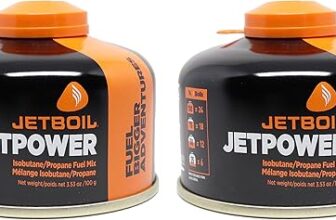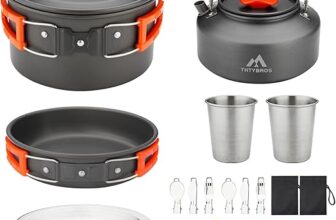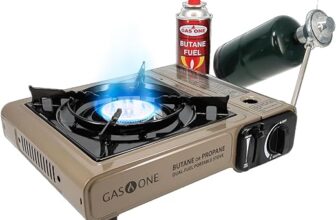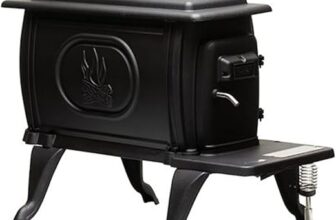
Did you know that nearly 70% of outdoor enthusiasts report feeling cold at night while camping? This startling fact underscores the importance of choosing the right sleeping bag—after all, a poor choice can make the difference between a restful night under the stars and a miserable experience that leaves you longing for the comfort of home. Whether you’re a seasoned adventurer or a weekend warrior, the complexities of seasonal changes can complicate your sleeping arrangements. In this blog post, we’ll delve into the essential factors to consider when selecting the best sleeping bag for each season, ensuring that your next camping experience is not only enjoyable but also safe and comfortable. Let’s get started!



Understanding Sleeping Bag Temperature Ratings
Choosing the right sleeping bag can be a daunting task, especially when it comes to understanding temperature ratings. With various systems in place, knowing how to interpret these effectively can make all the difference in your comfort and enjoyment during outdoor adventures. In this section, we dive into the intricacies of sleeping bag temperature ratings, unveiling what they mean, how they vary from manufacturer to manufacturer, and how personal factors influence your warmth.
The Importance of Temperature Ratings
Sleeping bag temperature ratings are essential because they provide a guideline for the lowest temperature in which you can sleep comfortably. A correctly rated sleeping bag can keep you warm and cozy, while a poorly rated one may leave you shivering through the night. Thus, it’s vital to understand both the rating system used and individual variables that might impact warmth.
Understanding Rating Systems
Manufacturers employ various standards to assess the performance of their sleeping bags. The two most notable are the EN (European Norm) and ISO (International Organization for Standardization) ratings.
1. The EN (European Norm) Rating System
- Comfort Rating: This indicates the lowest temperature at which a standard woman can sleep comfortably.
- Limit Rating: This demonstrates the lowest temperature at which a standard man can sleep.
- Extreme Rating: This signifies the absolute minimum temperature at which the sleeping bag can be used but is not recommended for extended periods.
For example, the Sea to Summit Flame FSleeping Bag may have ratings like:
- Comfort: 0°C (32°F)
- Limit: -5°C (23°F)
- Extreme: -20°C (-4°F)
2. The ISO Rating System
This system also breaks its ratings into three categories, similar to the EN, but it varies slightly in rules and procedures:
- Comfort and Limit Ratings: These are calculated under similar considerations as the EN but can be subjected to different testing environments and methodologies.
- Lower Limit: The lowest temperature at which a sleeper can remain for eight hours without getting too cold.
For example, the Therm-a-Rest Questar 20 might have ratings such as:
- Comfort: -6°C (21°F)
- Limit: -12°C (10°F)
With these examples, having a clearer image of how comfort is accounted for based on gender can guide you in making a selection that fits your needs.
Personal Factors Influencing Comfort and Warmth Retention
While temperature ratings offer crucial insights, personal factors also significantly affect how well you stay warm while sleeping outdoors. A few things to consider include:
Metabolism
Your body’s metabolism plays a key role in how warm you feel. For instance, more active individuals with higher metabolic rates tend to generate more body heat, which might allow them to sleep comfortably in lower temperature ratings than someone with a slower metabolism.
Clothing Choices
What you wear inside your sleeping bag can heavily impact your warmth. Layering thermal underwear, such as the Patagonia Capilene series, can effectively boost your warmth without bulk. Avoid cotton fabrics, as they retain moisture and cool you down, opting instead for materials like wool or fleece.
Sleeping Pad Choice
The type of sleeping pad you use can also affect heat retention:
- Insulated Pads: High R-value sleeping pads like the Sea to Summit Ether Light XT offer increased insulation from the cold ground, ensuring you stay warmer.
- Self-Inflating Pads: Models like the Therm-a-Rest ProLite provide decent warmth with air chambers that trap heat.
Practical Tips for Comfort
- Choose the right sleeping bag rating based on your expected conditions and personal factors.
- Layer appropriately inside the bag for added insulation.
- Utilize a high R-value sleeping pad to enhance warmth insulation from the ground.
Quick Reference: Comparison of Sleeping Bag Models
| Sleeping Bag Model | Comfort Temp | Limit Temp | Extreme Temp | Notable Features |
|---|---|---|---|---|
| Sea to Summit Flame F | 0°C (32°F) | -5°C (23°F) | -20°C (-4°F) | Ultralight, high warmth-to-weight ratio |
| Therm-a-Rest Questar 20 | -6°C (21°F) | -12°C (10°F) | -20°C (-4°F) | Down insulation, packable design |
| REI Co-op Magma 15 | -9°C (15°F) | -13°C (9°F) | -20°C (-4°F) | Water-resistant down, lightweight |
By understanding temperature ratings along with personal variations, you’ll be better prepared for your next camping escapade, allowing for a more enjoyable and comfortable night under the stars.
Choosing the Right Sleeping Bag for Winter
When it comes to winter camping, choosing the right sleeping bag is paramount to ensure warmth, comfort, and safety. Unlike summer or three-season bags, winter sleeping bags must guard against colder temperatures and moisture. This section delves into the key features that make sleeping bags suitable for winter adventures, offering guidance on insulation types, construction techniques, and recommended products.
Insulation Types: Down vs. Synthetic
Two primary types of insulation dominate the market for sleeping bags: down and synthetic. Each has its strengths and weaknesses, and understanding these differences will help you make an informed choice.
Down Insulation
Down insulation is made from the soft feathers underneath the outer feathers of ducks or geese, making it extremely lightweight and compressible.
Advantages of Down:
- Warmth-to-weight ratio: Down provides more insulation for less weight, ideal for backpacking in winter.
- Packability: Compresses compactly, freeing up space in your gear.
- Longevity: High-quality down bags can last for decades with proper care.
Disadvantages of Down:
- Water sensitivity: Down loses its insulating properties when wet, unless treated with a water-resistant coating.
- Cost: Generally more expensive than synthetic options.
Recommended Down Bags:
- Western Mountaineering Badger (Temperature Rating: 15°F): Renowned for its high-quality down and lightweight design.
- Sea to Summit Eucair 700 (Temperature Rating: 25°F): Excellent thermal performance packed in a small volume.
Synthetic Insulation
Synthetic insulation, typically made from polyester, imitates the properties of down and retains insulating properties even when damp.
Advantages of Synthetic:
- Water resistance: Maintains warmth even when wet, ideal for snowy conditions.
- Affordability: Usually more budget-friendly than down.
- Ease of care: Typically machine-washable without damaging the insulation.
Disadvantages of Synthetic:
- Weight and bulk: Generally heavier and bulkier than down options with similar warmth levels.
- Durability: May not last as long as high-quality down bags.
Recommended Synthetic Bags:
- REI Co-op Magma 15 (Temperature Rating: 15°F): A great balance of warmth, weight, and price, with excellent water-resistant properties.
- Marmot Trestles 15 (Temperature Rating: 15°F): Highly affordable synthetic option designed for cold weather, boasting a roomy design.
Construction Techniques: Baffles and Draft Collars
The way a sleeping bag is constructed plays a critical role in its overall warmth and comfort, particularly in harsh winter conditions.
Baffles
Baffles are the compartments in a sleeping bag that hold the insulation in place. There are several types:
- Horizontal Baffles: Distribute insulation uniformly across the bag, commonly found in down bags.
- Vertical Baffles: Chin up insulation, ideal for reducing weight.
- Trapezoidal Baffles: Enhance warmth by minimizing cold spots typically found in conventional baffles.
When selecting a sleeping bag, consider additional baffle features such as cross-baffles designed to keep insulation from shifting, which is especially helpful in down bags to prevent cold spots.
Draft Collars
Draft collars are insulated tubes that encircle the neck area to minimize heat loss, especially important during winter. A quality draft collar provides:
- Effective insulation: Keeps body heat inside the bag and prevents cold air from entering.
- Comfort: Offers a snug fit that enhances warmth without restricting movement.
For best results, look for bags that incorporate well-designed draft collars, adjusting easily for personalized comfort.
Materials That Enhance Warmth and Reduce Weight
The outer materials of sleeping bags significantly influence both warmth and packability:
- Nylon or Polyester Shells: Most winter bags utilize lightweight nylon or polyester fabrics that are durable, water-resistant, and lightweight.
- Water-resistance Treatments: Look for Durable Water Repellent (DWR) finishes on the bag shell, ensuring that moisture beads off rather than saturating the material.
- Inner Linings: A soft lining can provide additional comfort against the skin while retaining warmth.
Selecting a quality outer material can significantly enhance the longevity of your sleeping bag along with its performance during winter conditions.
Popular Winter Sleeping Bags and Temperature Ratings
Understanding temperature ratings is crucial when selecting a sleeping bag for winter camping. The following is a comparison table summarizing some top recommendations based on their insulation types and temperature ratings:
| Brand & Model | Insulation Type | Temperature Rating | Key Features |
|---|---|---|---|
| Western Mountaineering Badger | Down | 15°F | Lightweight, high-quality down |
| Sea to Summit Eucair 700 | Down | 25°F | Great packability |
| REI Co-op Magma 15 | Synthetic | 15°F | Excellent water resistance |
| Marmot Trestles 15 | Synthetic | 15°F | Affordable and roomy |
When choosing your winter sleeping bag, consider your specific winter conditions (like humidity and moisture exposure), your own preferences for weight versus insulation, and budget constraints. Being proactive with research will lead you to a sleeping bag that keeps you warm, comfortable, and enjoying the great outdoors all winter long.
Summer Sleeping Bags: Lightweight and Breathable Options
When considering camping gear for the warmer months, a summer sleeping bag plays a crucial role in ensuring a comfortable night’s sleep while minimizing bulk and weight. In this section, we’ll explore the key characteristics of summer sleeping bags, delve into materials that enhance comfort and performance, and compare popular models available on the market.
Characteristics of Summer Sleeping Bags
Lightweight Design
Summer sleeping bags are designed to be lighter than their three-season or winter counterparts. This reduces the overall weight of your backpack, allowing for easier transport during hikes or camping trips. The average summer sleeping bag weighs between 1-2 pounds, making them easy to carry without sacrificing comfort.
Breathable Materials
Summer nights can get hot, which is why choosing a sleeping bag with breathable materials is essential. Fabrics such as nylon or ripstop polyester are commonly used in summer sleeping bags due to their lightweight and moisture-wicking properties.
Key Features to Look For:
- Moisture-Wicking Fabrics: Help manage perspiration and enhance comfort.
- Ventilation Options: Features like zippers or draft collars can help regulate temperature.
- Quick Drying: Bags that dry quickly are advantageous in humid conditions.
Importance of Moisture Management
Staying dry and comfortable at night is paramount when camping in warm weather. Opting for a summer sleeping bag that incorporates materials designed to wick moisture away from the body can prevent overheating and ensure a restful night’s sleep.
Recommended Materials:
- DriDown™: A high-performance down alternative that stays dry for longer.
- Thermolite®: Synthetic insulation known for its lightweight properties and effective moisture management.
Shape Matters: Mummy vs. Rectangular
The design shape of a sleeping bag also influences your overall comfort.
Mummy Sleeping Bags
- Features: Fitted at the feet and tapered towards the head.
- Benefits: Retains heat better due to reduced air space, ideal for warmer nights when absolute comfort is key.
- Examples:
- Teton SportsTracker Ultralight Mummy Sleeping Bag: Lightweight (just under 2 lbs) and made of moisture-wicking fabric, it keeps you cool during hot nights without compromising warmth.
Rectangular Sleeping Bags
- Features: Box-shaped and spacious, offering more mobility.
- Benefits: Offers room for movement and can accommodate those who prefer a more traditional blanket feel.
- Examples:
- Coleman Green Valley Sleeping Bag: Designed for summer camping, featuring thermolock to retain heat while still offering breathability.
| Feature | Mummy Sleeping Bag | Rectangular Sleeping Bag |
|---|---|---|
| Width | Narrower at shoulder, wider at feet | Spacious all around |
| Weight | Typically weighs less | Generally heavier |
| Heat Retention | Higher, retains body heat | Lower, allows for more airflow |
| Comfort | Ideal for cooler summer nights | More room to move, great for warm nights |
| Examples | Teton Sports Tracker, REI Co-op Trail | Coleman Green Valley, The North Face One Bag |
Top-Rated Summer Sleeping Bags
For those gearing up for warm-weather camping trips, here are some highly recommended summer sleeping bags based on expert reviews and customer feedback:
- Sea to Summit Escape Bivi
- Weight: 1 lb 11 oz
- Temperature Rating: 45°F (ideal for summer)
- Features: Mummy shape, moisture-wicking fabric, lightweight, water-resistant.
- Big Agnes Fish Hawk 30
- Weight: 2 lbs 1 oz
- Temperature Rating: 30°F (best for cooler summer nights)
- Features: Synthetic insulation with excellent moisture management, spacious design.
- REI Co-op Flash Sleeping Bag
- Weight: 1 lb 14 oz
- Temperature Rating: 50°F
- Features: Minimalist design for ultralight backpacking, filled with recycled materials for sustainability.
By understanding the specific characteristics of summer sleeping bags and considering options that emphasize lightweight and breathable qualities, you can make an informed decision that enhances your summer camping experience. Selecting the right sleeping bag can dramatically impact your comfort level, ensuring that you wake up refreshed and ready for your adventures
Summing Up Your Perfect Sleeping Bag Choice
In conclusion, selecting the ideal sleeping bag for each season requires careful consideration of temperature ratings, insulation types, and specific seasonal needs. By keeping these factors in mind, you can choose a sleeping bag that ensures your comfort and safety, whether you’re venturing into the depths of winter, enjoying summer nights, or navigating unpredictable weather in between. Ultimately, whether you opt for a versatile all-season bag or separate bags for different conditions, the right choice will enhance your outdoor experience. Happy camping!









Hey, could you expand a bit more on how the temperature ratings are determined? I always get confused about what they actually mean in real-world scenarios!
When choosing a sleeping bag, don’t forget about the shape! I prefer a mummy bag for warmth, but some people swear by rectangular ones for extra space. What do you guys think?
Absolutely! The shape can definitely impact your comfort and warmth. Mummy bags are great for heat retention, while rectangular bags offer that extra wiggle room. It’s all about personal preference!
I just got a REI Co-op Trailbreak 20 for winter camping, and it’s been a game changer! Super warm without being too heavy. Anyone else have favorite winter bags?
Awesome choice! The REI Co-op Trailbreak 20 is really popular. I’d love to hear more about your experiences with it during your trips!
Also, I’ve found that a good sleeping pad can make a huge difference! Even with a great sleeping bag, if your pad isn’t insulated well, you’ll still feel cold. Anyone have recommendations?
Yes! A quality sleeping pad is essential for warmth and comfort. I personally recommend the Therm-a-Rest NeoAir XTherm for serious insulation. Thanks for sharing your tip!
Great question! Temperature ratings can vary based on brand and model, but they usually consider factors like insulation type and bag shape. I’ll look into providing more detailed info in a future update!